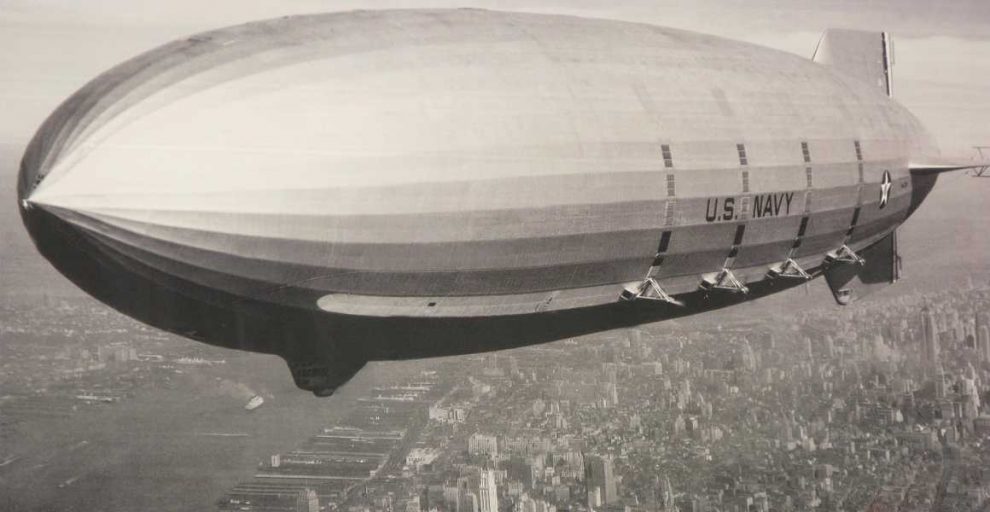Zeppelins look “like long tubes” and they were very popular rigid airship form originally manufactured by Luftschiffsbau Zeppelin. Although only airships produced by this company are true zeppelins, fastly all airships adopted that name. Zeppelins have an important role in aviation development. We define them as aircraft used for flying, which is filled with a gas lighter than air.
In this text we are going to reveal the mystery of Zeppelins: large constructions usually remembered as airships used by Germans to transport bombs during World War II. Is there more to Zeppelins than military usage?
What are Zeppelins made of?
The form of a zeppelin is probably familiar to all – it has a shape similar to today’s rocket ships. When you think of the size of it the question arises: how was it built in the 1930s?
Funnily, the answer is too simple – by using the largest ladders you can imagine. First made zeppelin contained approximately 11.300 cubic meters of hydrogen which was packed into 17 gas cells made of rubberized cotton fabric. There are two metal gondolas below the ship, and each produces about 14 horsepower. They use a 4-cylinder water-cooled Daimler gasoline engine, and each engine is connecter by long shafts to two outrigger propellers mounted on either side of the hull.
The main problem of this first version of zeppelin was there were no elevators for pitch controls, or fins for stability. Pitch was controlled by a sliding weight suspended under the hull which could be shifted fore and aft. This solution wasn’t good enough. In addition to that, it was too heavy and hard to manoeuvre.
During the following year, there were a couple more designs of zeppelins which were solving the main first version’s problems. The final design LZ-4 mastered the basis of airship design and operation. The ship could make an endurance flight of 24 hours, it was stable, faster and lighter. New engines produced about 80 horsepower. Large horizontal fins and elevators provide great stability.
What are Zeppelins used for?
The primary role of zeppelins was as a military aircraft during World War I. During this period German Zeppelin wrought terror over the opponents. It was said that they are not too dangerous, but scary as hell. They were large, unpredictable, and noisy. At first, they were used for reconnaissance. On January 19th 1915. the first air attack occurred. The advantage of these air raid was that people weren’t able to predict them. Zeppelins would come out of the dark, absolutely without any order and caused chaos and panic.
A typical zeppelin could carry five 50 kilograms high-explosive bombs and 20 incendiary bombs, 2,5 kilograms each. The most terrific attack over London resulted in 22 victims, 87 hard injuries and without any damage to the zeppelin.
When a cure for this air beast was founded, the role of zeppelins in the war reduced, and in 1918. It stopped completely.
Besides the scary part of their history, zeppelins were used for many other things.
By the 1930s zeppelins were considered a technological marvel. There were luxury airships which were waving the passengers over the Atlantic ocean.
Related to their surveillance role during the war, today zeppelins are often used for photography at events and as massive flying billboards, for example for companies.
A short history of Zeppelins
Zeppelins are rigid airships manufactured by a Luftschiffbau Zeppelin of Germany, which was founded by Count Ferdinand von Zeppelin. He is considered the father of the rigid airship. It is important to know that not all airships are “zeppelins”, only ones produced by the mentioned company are.
Many years ago, when cheap plane tickets were not even a dream, zeppelins ruled the skies.
First Zeppelin was LZ-1 (“Z” standing for Zeppelin), and it started its brief existence in winter 1899. The ship was inflated with hydrogen and made its maiden flight in summer of 1900. This flight lasted a whole 18 minutes.
First versions of zeppelins had many problems, which were solved by time. Definitely the most successful zeppelin ever built was LZ-127 and got the name by Mr Ferdinand’s daughter – Graf Zeppelin. This zeppelin was famous thought the world, since in cruised around the globe for nine years and started an international zeppelin fever in the late 1920s and early 1930s.
As we have already mentioned, zeppelins were used in bombing operations during World War I.
The zeppelin fever ended in 1936. when second most famous zeppelin burst into flames and it was completely destroyed. In this accident, known as the Hindenburg disaster, 36 people died. During World War II the Zeppelin airship works were destroyed by Allied bombing. Building these huge rigid airships was never resumed.
In 2001. smaller helium-filled zeppelin was built – Zeppelin NT (NT stands for New Technology). This zeppelin began his journey as a sightseeing airship for short trips over Lake Constance and other locations.
First commercial flights
First passenger airline in the world was DELAG (Deutsche Luftschiffahrts-Aktiengesellschaft, or German Airship Transportation Corporation Ltd). It was established in 1909. as a branch of the Zeppelin Company. The idea of the company was to commercialize passenger air service. The company was providing passenger air service until 1935. Then a new company was formed – Deutsche Zeppelin-Reederei.
As we already mentioned, flights were mostly sightseeing tours. However, one airship named Bodensee scheduled the first service between Berlin and southern Germany in 1919. The flight lasted 4 to 9 hours. On the other hand, it took 18 to 24 hours to the train to go over the same distance. This airship made 103 flights and carried almost 2,500 passengers. This was the first civilian zeppelin.
The Bodensee could carry up to 26 passengers, and it had washrooms and a small kitchen for light meals, which makes it a forerunner of the aeroplanes.
DELAG was a company that also offered the first transatlantic passenger airline service. The airship used for it was LZ-127 Graf Zeppelin. It flew from Germany to South America for the first time in 1931. and then 136 more times. This airship retired after the tragic Hindenburg disaster in 1937.
How much does it cost?
Today flying by zeppelin is a special kind of adventure. To see a zeppelin flying over blue skies is not that common – and accordingly, it costs extra.
There are not many companies that offer zeppelin rides, and the biggest one is (logically) stationed in Germany. Most sightseeing flights are offered by already mentioned Deutsche Zeppelin-Reederei, which operates a Zeppelin NT airship (semi-rigid airship inflated with helium). The ship made its first flight in 1997, and it can accommodate up to 14 passengers and 2 pilots. Fun fact is that this zeppelin is even bigger that Boeing 747-400, which is 71m long. The Zeppelin NT is 75m long.
When it comes to the price of this one-of-a-kind experience, it depends on the duration of the flight. The shortest one lasts 30 minutes, and the price is about 250 euros. We can agree that it is way more expensive compared to the cost of an aeroplane ticket.
If you are looking for a cheap ticket, you can always look at the prices of low costs airlines, and find a ticket for an international flight for even 20 euros. This price, of course, depends on many factors, such as time of the year, how much in advance are you buying your ticket, destination, et cetera.
Nevertheless, zeppelins are still a not preferable way of transportation today. According to the price, you should probably decide to use them as a special experience which is not likely to happen again any time soon. The price of the longest flight, which lasts for 2 hours, is about 825 euros.
Why Zeppelins aren’t used as much today?
There are several reasons why the aeroplane won the fight for people’s hearts and ticket fees. Obviously, aeroplanes do have advantages over zeppelins in cost, speed and conditions of use.
Conditions of use – there is no use if the sun doesn’t shine
There is something unpredictable that can totally destroy your dreams about flying in the large “tube”. It’s the weather. This is the first point where things go downhill for zeppelins. Zeppelin cannot be used in the periods of thunderstorms, heavy rain or strong wind. It is said that zeppelins are like big sails since it has so much fabric. This means that it can be tricky to fly with it during the stormy and windy days.
The zeppelin just can’t stay on track when the wind is pushing it sideways. It can even move the ship when it is tethered down. It also slows down the flying zeppelin, which wouldn’t happen to an aeroplane.
On the other hand, aeroplanes can take off during almost any kind of weather. Some rain and wind cannot stop it from cruising the skies. The aeroplane won’t take off only during really strong and heavy storms, or in cases of lack visibility, because of the snow for example. This makes them much more practical comparing to the zeppelins.
Speed – no, we are not there yet
Speed is one of the main reasons why zeppelins lost the battle to the aeroplanes. Zeppelins aren’t really the best choice when you want to get from point A to point B. They need much more time, and time is the most expensive resource one person has.
On the other hand, when it comes to aeroplanes you can go across continents in a couple of hours. Since February 5th 2017. the longest aeroplane non-stop flight is from New Zealand to Qatar. The duration of the flight is 18 hours, and during that time the aeroplane goes over 14,534 kilometres. This is a record no single zeppelin can ever surpass.
Cost – a kick on the pocket
The issue of expense is often the most important one. Because let’s face it – not many people are willing to pay a couple of hundred dollars a few times a year to visit relatives abroad or to go on vacation.
Cheap flights are something you can enjoy when it comes to the aeroplanes. There are low-cost flights and last minute flights. Cheap airline tickets are not strictly limited resource. If you book your flight on time there is a high chance you will get your ticket for a ridiculously low price.
However, there is no such thing as a ridiculously low price when it comes to zeppelins. Fly tickets are really expensive and usually booked a few months in advance. So if you want to buy a ticket, first you will need a couple of hundred dollars of a really short flight, and you have to book a couple of months ahead.
“Only 12 people”, please
Another reason why zeppelins aren’t used as much today is the number of passengers it can carry. Zeppelin NT can carry 12 passengers (all with window seat) and 2 crew members. LZ-127 Graf Zeppelin could carry 20 passengers and 36 officers and crew. Comparing to this, the largest aeroplane today can carry 853 passengers at a time (Airbus A80). There is no need to explain this further.
What is the difference between blimp and zeppelin?
Now when we are familiar with zeppelins, we should explain the difference between a zeppelin and a blimp, since today blimps are used more than zeppelins in commercial purposes.
A blimp can be explained as a “pressure airship” which is powered and lighter-than-air vehicle. Its shape is maintained by the pressure of the gases within its envelope. If a blimp deflates it loses its shape, and that is the main difference between blimp and zeppelin. The blimp is not a rigid airship form.
Zeppelins have rigid metal skeletons, so they are suitable for longer trips and in a wider variety of weather conditions (which are also limited, as we previously explained). This also makes them more expensive. On the other hand, blimps are simply shaped balloons with fins and engine. They get their shape through the overpressure of the gas.
Small RC blimps – what are they used for today?
More often you can find RC blimp for sale because their one, the great advantage is that they can fly over without expending fuel or energy, which consequently means that it can stay aloft for days. That is much longer than an aeroplane. This is why these non-rigid airships are used today for covering sports events, advertising and research, for example scouting for whales. In addition to this, they are used for lifting and transporting heavy cargo loads, for example, ships and oil rigs.
Blimps can be very effective advertising instrument. There are 13 active advertising airships in the world. They are ideal for outdoor advertising, and can be an exceptionally good way to attract people’s attention. They can fly up to 60 meters in height, so your branding can be seen far from the location of the blimp.
They can be used for indoor advertising as well, and they are easy to install.
When it comes to the visualisation, in both cases you can choose the size of the blimp, colour, and how big your logo or message is going to be. When it comes to the price, it depends on the mentioned factors. You can think of it as pricy or not, depending on the means you use to advertise yourself. But it is without any doubt effective. Blimps will help you make a huge impression on your audience.
When it comes to the blimps on sports events, it all started with providing bird’s eye perspective of the Olympic games in Los Angeles in 1932. Since then, blimps were a meaningful part of many different sports events.
In addition to this, science is no foreigner to the blimp renting and selling companies. Many blimps are used as platforms for atmospheric measurements, university research and scientific applications.
Furthermore, there are also surveillance blimps which are used for air surveillance of the cities. This type of blimp was used by the military for years. These are used for traffic surveillance as well.
Three fun and shocking facts
- The first commercial zeppelin flight was in 1910.
- Gasbags of many rigid airships were made of sheets of so-called “goldbeater’s skin” which is made from the intestines of cows. A typical World War I Zeppelin needed about 200,000 sheets.
- The first airships contained hydrogen, which is lighter than air. From the first flame until the whole of the Hindenburg’s envelope was completely burnt – passed 37 seconds. Hydrogen is also very flammable and dangerous. It was replaced by helium.
To conclude…
Zeppelins had a rich and colourful history and played an important role in many historic events. Today zeppelins are sometimes used for sightseeing, but more often you can meet with blimps, non-rigid aircraft, which have many different purposes. One thing is for sure – if you decide to have a ride in one of these things it will be one-in-a-lifetime feeling.
Remark
-
Remark
















People demands to travel fast from A to B. Cargo do not have the same demands. A freighter from New Zealand to Qatar, distance of 14,534 kilometres at 16-18 knots will take days. During its trip it has to get diesel, that emits carbondioxid, PM 1, PM 2,5, PM 5. Every harbour costs to build, maintain who pays that? People departing from A to B usually departs from an airport. What is the cost to build and maintain this. Who pays? Railroad, cargo on rail, what is the cost to build and maintain, who pays? How large is the series of Boing 777? Does that effects serial cost of the air-plane, of course it does. Did you know that the 777 was al constructed in computers. Not one piece of alumine was moulded before the total blueprint was done. Even the service personal had their saying if it was possible to clean the cabins at defined time before passengers boarded. Their is no CAD/CAM systems holding such a design roles for airships. We are back in the 1936 years constructions support for airships. No wonder they cost. About cost. What do Boing 777 cost, about 350 Million $ takes about 300-400 passengers. Boing order-book is about 35-45 signed orders. But development cost where about 5.5 billion $. I believe that more financial patience, with sufficient budget and time airships can help us transport up to 250, 500, and 1000 metric tons of cargo from A to B and not in 800 km/h but a lot faster then 16-18 knots.